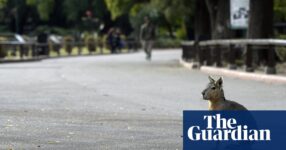
From showing animals for profit to protecting them: the reinvention of Buenos Aires zoo | Zoos
A mara, stretched out under the shade of a huge ombu tree, greets you at the entrance to the Buenos Aires Eco-park. It’s just one of dozens of the hare-like rodents that roam the grounds of the former city zoo.
Today, only a few “legacy animals” remain in Buenos Aires, those hard to relocate due to their age. These include two hippos, which wallow in a new enclosure; a pair of geriatric giraffes; two aged elephants, which have regular podiatry sessions; and an arthritic camel, which receives acupuncture and magnet therapy five times a week.
The zoo closed its gates for the last time in 2016. Public opinion in the city had turned against the idea of displaying animals for entertainment, often in enclosures that had changed little since they were built in the late 1800s. Over the past seven years, more than 1,000 animals have been moved to sanctuaries around the world, reflecting how the park’s remit has changed from providing amusement to becoming a nationally important centre for conservation.
“As a zoo, conservation came second to its primary purpose of making money,” says Dolores Medina, the park’s coordinator of conservation and wildlife. “[Now] we don’t have animals here for the purpose of being shown to the public … We work for the conservation of species but also to make people aware of how they are impacting animals.”
While some of the old, listed buildings are being restored, others are being repurposed as offices, cafes and education centres. The zoo’s baboon house has been transformed into a state-of-the-art animal hospital, which takes in injured wild animals from all over Argentina, and also houses the largest biobank in South America, with genetic material from 120 species held in cryogenic suspension.
The process wasn’t entirely smooth: there were protests after more than 100 animals died in the years after the zoo’s closure. As well as old age, many of the deaths were blamed on poor care and management. Since then, the team behind the ecopark has worked hard to win back trust, of local people as well as of other conservation professionals.
Buenos Aires isn’t the only zoo in Argentina that is changing. Those in Mendoza and Córdoba have also become ecoparks, while the zoo in Medellín, Colombia, has been rebranded as a conservation park, and the national menagerie in El Salvador has been mothballed.
According to Chris Lewis, a captivity research officer at Born Free, a wildlife charity that has long campaigned against keeping animals in zoos, there is a growing trend for ecoparks in South America, as visitor numbers fail to reach the levels that zoos in Europe and North America enjoy.
There had also been “high levels of criticism towards some of these facilities”, he says, from a polar bear dying during an Argentinian heatwave to the unexplained death of a hippo in El Salvador.
The park in Buenos Aires is still open to visitors, but numbers are restricted to 2,000 a day, and its focus is on operating as a conservation and rescue centre.
The park cares for injured animals from all over Argentina, says Medina, supporting provinces which don’t have the same modern facilities, and helping to re-stock Argentina’s biodiversity. “There’s a trust involved in other provinces giving us their rescued animals to rehabilitate,” she says.
The park runs a dozen conservation programmes, working closely with Rewilding Argentina to bring the red-and-green macaws back from the brink of extinction. Many birds are hand reared at the park, Medina says, using a mixture of glove puppets and mirrors so that they wouldn’t associate humans with food, techniques which are now being used by other institutions.
The park has also worked closely with Fundación Bioandina to release 240 Andean condor back into the wild, and there are also conservation programmes for tapirs and the giant tortoise, which was hunted to extinction. The valcheta frog, listed as critically endangered by the IUCN,has been decimated by the introduction of exotic fish, such as trout. This year, the park was able to breed and then release 2,330 frogs.
Equally at risk is the Apipé water snail, another creature with a restricted habitat, close to the border with Brazil. A hydroelectric dam has turned the once fast-flowing, highly oxygenated water the snails relied on into a lake, where a parasite that causes infertility in the snails has thrived. Now several tanks at the ecopark are dedicated to recreating the exact conditions the snail needs to breed, with more than 1,000 to be reintroduced.
“At the beginning, it was a real challenge because no one really knew what we were trying to do,” says Medina. But over time, she says, the park has gained the trust of the public and the scientific community, who understand their focus is on protecting native species not displaying exotic ones.
As a result, many conservation organisations now see them as a partner, she says: “In that respect, we have achieved what we set out to do.”
Find more age of extinction coverage here, and follow biodiversity reporters Phoebe Weston and Patrick Greenfield on X (formerly known as Twitter) for all the latest news and features



